Tire Sizes for 15 Inch Rims

So, you’ve got 15-inch rims on your vehicle and you’re in the market for new tires. But with a plethora of numbers and letters staring back at you from tire walls, it can feel a bit overwhelming. Fear not! Let’s dive into understanding tire sizes, especially for those trusty 15-inch rims, in a way that’s both informative and easy to digest.
Decoding Tire Size
First things first, let’s break down what a typical tire size looks like. Take, for example, 195/65R15. This sequence isn’t just random; it tells a detailed story about the tire.
- 195: This is the tire width in millimeters. So, the tire is 195mm wide from sidewall to sidewall.
- 65: This number represents the aspect ratio. It’s the height of the tire’s sidewall expressed as a percentage of the tire’s width. In this case, the sidewall height is 65% of 195mm.
- R: This stands for Radial construction, which is the most common type in modern vehicles. It indicates how the tire’s internal layers are laid out.
- 15: This is the diameter of the wheel (or rim) the tire is designed to fit, measured in inches. In our context, all the tires fit 15-inch rims.
Understanding these numbers helps in selecting the right tire, ensuring safety, performance, and comfort.
Popular Tire Sizes for 15-Inch Rims
With the basics covered, let’s explore some of the most common tire sizes suitable for 15-inch rims. We’ll categorize them based on typical vehicle types for clarity.
For Passenger Cars
- 175/55R15
- 175/65R15
- 185/55R15
- 185/60R15
- 185/65R15
- 195/50R15
- 195/55R15
- 195/60R15
- 195/65R15
- 205/50R15
- 205/60R15
- 205/65R15
- 215/60R15
- 215/65R15
These sizes are commonly found on compact to mid-sized cars. For instance, the 195/65R15 is a popular choice for sedans, offering a balanced blend of comfort and performance.
For SUVs and Light Trucks
- 205/70R15
- 205/75R15
- 215/70R15
- 215/75R15
- 225/70R15
- 225/75R15
- 235/70R15
- 235/75R15
- 265/75R15
These tires are beefier, designed to handle the weight and demands of larger vehicles. The 235/75R15, for example, is a common fit for light trucks, offering durability and traction.
Specialty Off-Road Sizes
- 30×9.50R15
- 31×10.50R15
- 33×12.50R15
- 33×13.50R15
- 35×13.50R15
- 37×14.50R15
These sizes deviate from the standard metric measurements and are tailored for off-road enthusiasts. The first number (e.g., 31) indicates the tire’s overall diameter in inches, while the second (e.g., 10.50) denotes the tire’s width in inches. These tires are designed for rugged terrains, providing enhanced grip and durability.
Why the Right Tire Size Matters
Choosing the correct tire size isn’t just about aesthetics; it’s pivotal for your vehicle’s performance and safety.
- Handling and Stability: Tires influence how your vehicle responds to steering. An incorrect size can lead to decreased handling capabilities.
- Fuel Efficiency: Tires that are too big or too small can negatively impact fuel consumption.
- Speedometer Accuracy: Changing tire sizes can affect the accuracy of your speedometer, potentially leading to unintended speeding.
- Safety: Mismatched tires can lead to uneven wear, increased chances of blowouts, and compromised braking performance.
Tips for Selecting
- Consult Your Vehicle’s Manual: This is your primary source. Manufacturers specify optimal tire sizes for safety and performance.
- Check the Tire Placard: Usually found on the driver’s side door jamb, it lists recommended tire sizes and pressures.
- Consider Your Driving Habits: If you’re an off-road adventurer, those specialty sizes might be up your alley. For city driving, standard sizes suffice.
- Avoid Extreme Changes: While upsizing (choosing a larger tire) can enhance aesthetics or performance, drastic changes can have adverse effects. It’s best to stay within one or two sizes of the manufacturer’s recommendation.
- Seek Expert Advice: When in doubt, consult with tire professionals. They can provide insights tailored to your vehicle and driving needs.
Wrapping It Up
Navigating the world of tire sizes might seem daunting at first glance, but with a basic understanding and a keen eye on your vehicle’s requirements, it’s a journey you can confidently embark upon.
Remember, tires are the only contact point between your vehicle and the road. Ensuring they’re the right size and fit is paramount to a safe and smooth driving experience.
So, next time you glance at those numbers on a tire, you’ll know precisely what they signify. Here’s to rolling with the right fit!

